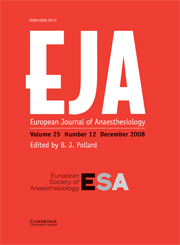Crossref Citations
This article has been cited by the following publications. This list is generated based on data provided by
Crossref.
Chien, I
Lu, I‐Chen
Wang, Fu‐Yuan
Soo, Lee‐Ying
Yu, Kwong‐Leung
and
Tang, Chao‐Shun
2003.
Spinal Process Landmark as a Predicting Factor for Difficult Epidural Block: A Prospective Study in Taiwanese Patients.
The Kaohsiung Journal of Medical Sciences,
Vol. 19,
Issue. 11,
p.
563.
Notcutt, W.
2004.
Development of a difficulty score for spinal anaesthesia.
British Journal of Anaesthesia,
Vol. 93,
Issue. 3,
p.
470.
Atallah, M.M.
Demian, A.D.
and
Shorrab, A.A.
2004.
Development of a difficulty score for spinal anaesthesia.
British Journal of Anaesthesia,
Vol. 92,
Issue. 3,
p.
354.
Meek, Tim
2004.
Epidural anaesthesia and analgesia in major surgery.
Current Anaesthesia & Critical Care,
Vol. 15,
Issue. 4-5,
p.
239.
Marhofer, P.
Greher, M.
and
Kapral, S.
2005.
Ultrasound guidance in regional anaesthesia †.
British Journal of Anaesthesia,
Vol. 94,
Issue. 1,
p.
7.
Pypendop, Bruno H.
Pascoe, Peter J.
and
Ilkiw, Jan E.
2006.
Effects of epidural administration of morphine and buprenorphine on the minimum alveolar concentration of isoflurane in cats.
American Journal of Veterinary Research,
Vol. 67,
Issue. 9,
p.
1471.
Nagaro, Takumi
Yorozuya, Toshihiro
Kamei, Michiko
Kii, Norikatsu
Arai, Tatsuru
and
Abe, Syungo
2006.
Fluoroscopically Guided Epidural Block in the Thoracic and Lumbar Regions.
Regional Anesthesia and Pain Medicine,
Vol. 31,
Issue. 5,
p.
409.
Hoppe, J.
and
Popham, P.
2007.
Complete failure of spinal anaesthesia in obstetrics.
International Journal of Obstetric Anesthesia,
Vol. 16,
Issue. 3,
p.
250.
Ghelber, Oscar
Gebhard, Ralf E.
Vora, Sejal
Hagberg, Carin A.
and
Szmuk, Peter
2008.
Identification of the Epidural Space Using Pressure Measurement With the Compuflo Injection Pump - A Pilot Study.
Regional Anesthesia and Pain Medicine,
Vol. 33,
Issue. 4,
p.
346.
2008.
CrossRef Listing of Deleted DOIs.
Ellinas, Elizabeth H.
Eastwood, Daniel C.
Patel, Smita N.
Maitra-D’Cruze, Anita M.
and
Ebert, Thomas J.
2009.
The Effect of Obesity on Neuraxial Technique Difficulty in Pregnant Patients: A Prospective, Observational Study.
Anesthesia & Analgesia,
Vol. 109,
Issue. 4,
p.
1225.
Chin, Ki Jinn
Perlas, Anahi
Singh, Mandeep
Arzola, Cristian
Prasad, Arun
Chan, Vincent
and
Brull, Richard
2009.
An ultrasound-assisted approach facilitates spinal anesthesia for total joint arthroplasty.
Canadian Journal of Anesthesia/Journal canadien d'anesthésie,
Vol. 56,
Issue. 9,
p.
643.
Fisher, Kyle S.
Arnholt, Alan T.
Douglas, Michal E.
Vandiver, Scott L.
and
Nguyen, Daniel H.
2009.
A Randomized Trial of the Traditional Sitting Position Versus the Hamstring Stretch Position for Labor Epidural Needle Placement.
Anesthesia & Analgesia,
Vol. 109,
Issue. 2,
p.
532.
Schmittner, M D
Schreiber, H
Janke, A
Weiss, C
Blunk, J
Bussen, D G
and
Luecke, T
2009.
Randomized clinical trial of perianal surgery performed under spinal saddle block versus total intravenous anaesthesia.
British Journal of Surgery,
Vol. 97,
Issue. 1,
p.
12.
Catchpole, Ken
and
McCulloch, Peter
2009.
Incidents in Anaesthesia: Past Occurrence and Future Avoidance.
Journal of Perioperative Practice,
Vol. 19,
Issue. 10,
p.
342.
O’Donnell, Dermot
Prasad, Arun
and
Perlas, Anahi
2009.
Ultrasound-assisted spinal anesthesia in obese patients.
Canadian Journal of Anesthesia/Journal canadien d'anesthésie,
Vol. 56,
Issue. 12,
p.
982.
Ruppen, W.
Steiner, L.A.
Drewe, J.
Hauenstein, L.
Brugger, S.
and
Seeberger, M.D.
2009.
Bupivacaine concentrations in the lumbar cerebrospinal fluid of patients during spinal anaesthesia.
British Journal of Anaesthesia,
Vol. 102,
Issue. 6,
p.
832.
Schmittner, Marc D.
Janke, Andrea
Weiss, Christel
Beck, Grietje C.
and
Bussen, Dieter G.
2009.
Practicability and patients' subjective experiences of low-dose spinal anaesthesia using hyperbaric bupivacaine for transanal surgery.
International Journal of Colorectal Disease,
Vol. 24,
Issue. 7,
p.
827.
Iff, Isabelle
Mosing, Martina
Lechner, Timo
and
Moens, Yves
2010.
The use of an acoustic device to identify the extradural space in standing horses.
Veterinary Anaesthesia and Analgesia,
Vol. 37,
Issue. 1,
p.
57.
Ting, Chien-Kun
and
Chang, Yin
2010.
Technique of fiber optics used to localize epidural space in piglets.
Optics Express,
Vol. 18,
Issue. 11,
p.
11138.




